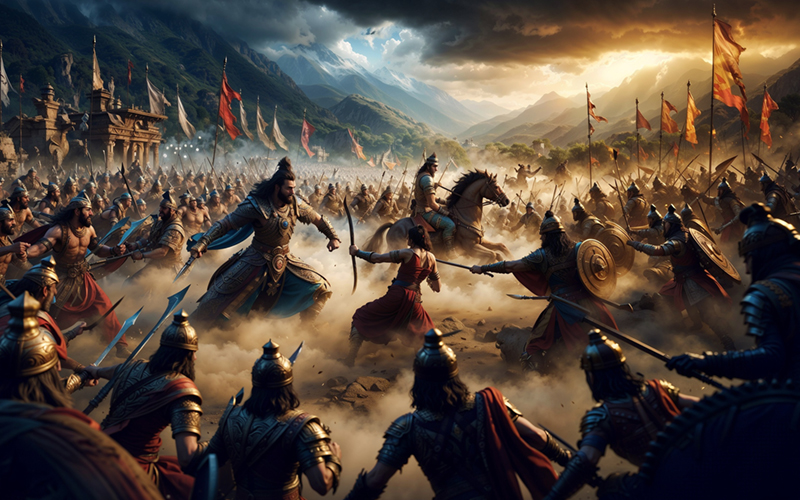Physical Address
Empirical System, 105 First Floor Pitru Krupa, Opp. R.K. Desai College, Koparli Road, Vapi (Gujarat) 396 191
Physical Address
Empirical System, 105 First Floor Pitru Krupa, Opp. R.K. Desai College, Koparli Road, Vapi (Gujarat) 396 191

The story behind the name “Mahabharata” and its contents:
Welcome to our channel! Today, we’re diving into the epic tale of the Mahabharata – one of the longest and most profound stories in human history.
“The Mahabharata: An Epic of Greatness”
The name “Mahabharata” is derived from two Sanskrit words: “Maha” meaning “great” and “Bharata” referring to the descendants of King Bharata. Thus, “Mahabharata” translates to “the great tale of the Bharata dynasty.”
The epic is attributed to the sage Vyasa and is a cornerstone of Indian literature. Originally, Vyasa named the epic “Jaya,” meaning “victory.” As the story grew in scope, encompassing not just the war but also life’s profound lessons, it became known as the Mahabharata.
Contents of the Mahabharata
The Mahabharata is divided into 18 books, known as parvas, and contains around 100,000 shlokas or verses. Here’s a quick overview of each parva:
1. Adi Parva (The Book of the Beginning): Introduces the Kuru dynasty, the birth of the Pandavas and Kauravas, and early events leading to the war.
2. Sabha Parva (The Book of the Assembly Hall): Describes the infamous dice game, Draupadi’s humiliation, and the Pandavas’ exile.
3. Vana Parva (The Book of the Forest): Chronicles the Pandavas’ 12 years in the forest.
4. Virata Parva (The Book of Virata): Narrates the Pandavas’ incognito year in Virata’s kingdom.
5. Udyoga Parva (The Book of the Effort): Covers the war preparations and peace negotiations.
6. Bhishma Parva (The Book of Bhishma): Details the first part of the war with Bhishma leading the Kaurava army.
7. Drona Parva (The Book of Drona): Continues the war with Drona as the commander.
8. Karna Parva (The Book of Karna): Focuses on the war led by Karna.
9. Shalya Parva (The Book of Shalya): Concludes the war with Shalya commanding the Kauravas.
10. Sauptika Parva (The Book of the Sleeping Warriors): Narrates the tragic killing of the sleeping Pandava soldiers by Ashwatthama.
11. Stri Parva (The Book of the Women): Laments the war’s aftermath through the eyes of the women who lost their loved ones.
12. Shanti Parva (The Book of Peace): Bhishma imparts wisdom on dharma to Yudhishthira.
13. Anushasana Parva (The Book of Instructions): Further teachings by Bhishma on governance and duty.
14. Ashvamedhika Parva (The Book of the Horse Sacrifice): Describes Yudhishthira’s Ashvamedha yagna.
15. Ashramavasika Parva (The Book of the Hermitage): The retirement of Dhritarashtra, Gandhari, and Kunti to the forest.
16. Mausala Parva (The Book of the Clubs): The downfall of the Yadava dynasty and the death of Krishna.
17. Mahaprasthanika Parva (The Book of the Great Journey): The Pandavas’ final journey to the Himalayas.
18. Swargarohini Parva (The Book of the Ascension to Heaven): Yudhishthira’s ascent to heaven and the conclusion of the epic.
Key Themes
The Mahabharata explores various themes like: Dharma (Righteousness): The complexities of doing what is right. Artha (Purpose): The pursuit of goals and responsibilities. Kama (Desire): The human emotions and passions. Moksha (Liberation): The ultimate goal of freeing oneself from the cycle of rebirth.
Philosophical Discourses
The epic also includes profound philosophical discourses such as:
Bhagavad Gita: A conversation between Krishna and Arjuna on the battlefield, covering life’s deepest spiritual truths.
Anu Gita: Additional teachings by Krishna found in the Ashvamedhika Parva.
Influence
The Mahabharata has deeply influenced Indian culture, philosophy, art, and literature. Its stories and lessons continue to inspire and teach timeless wisdom.